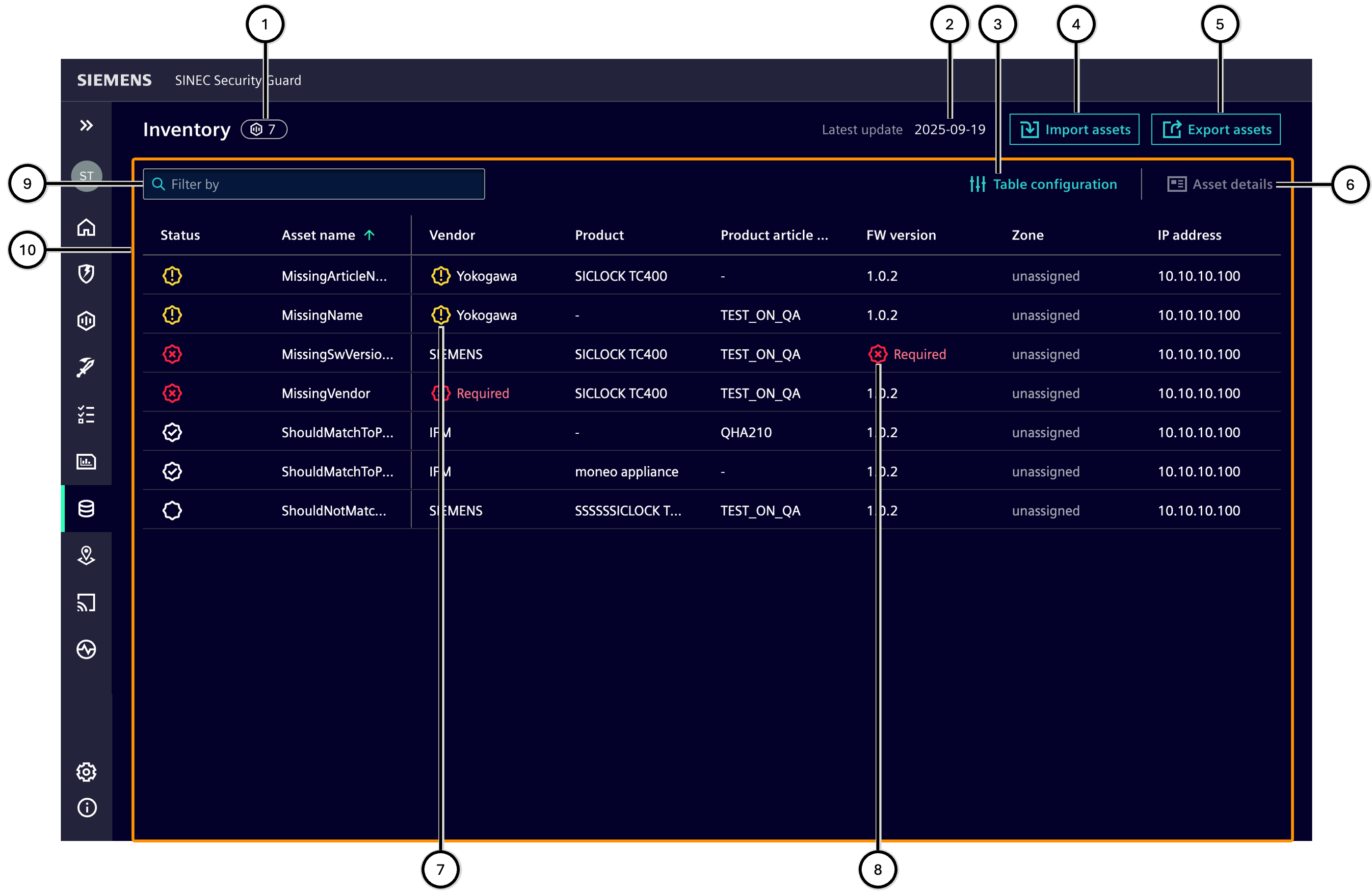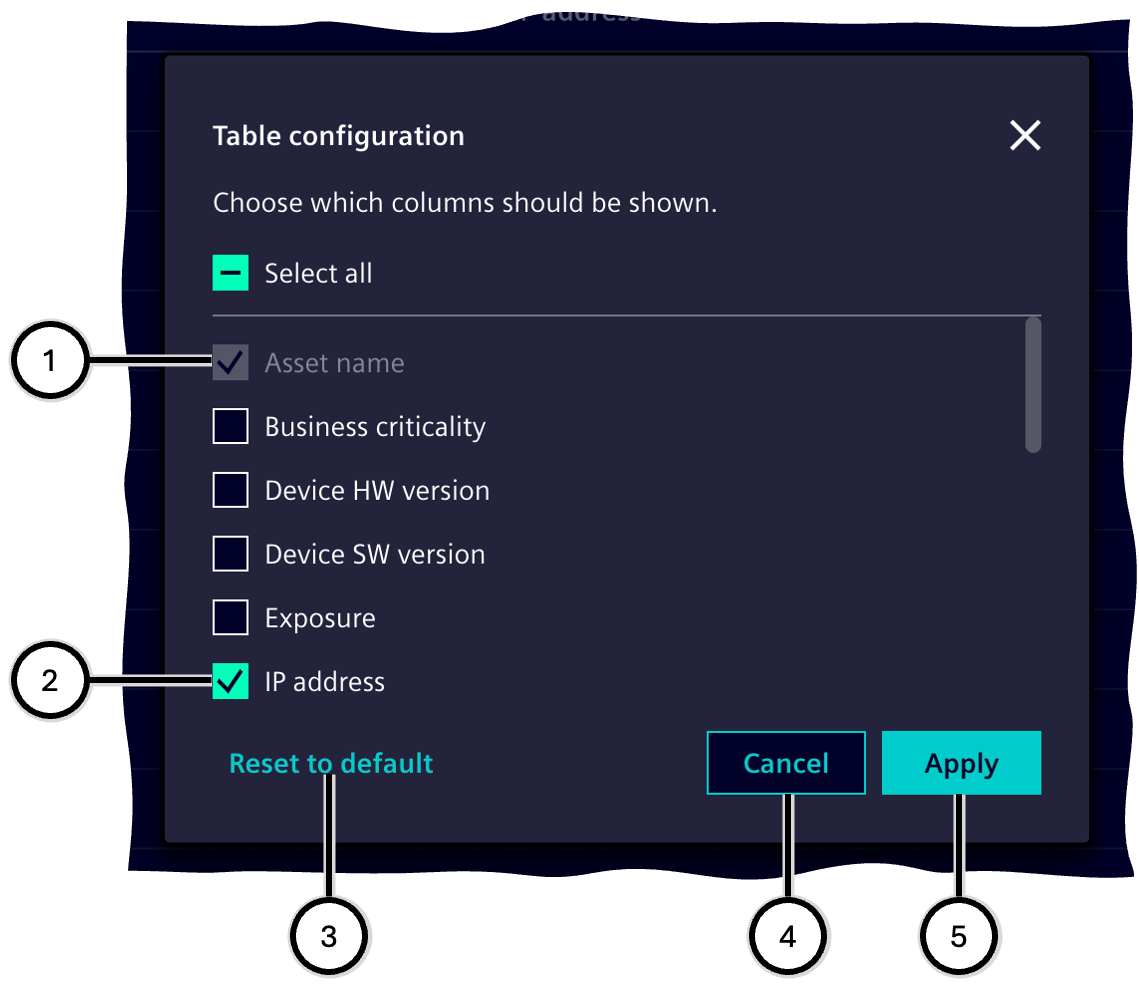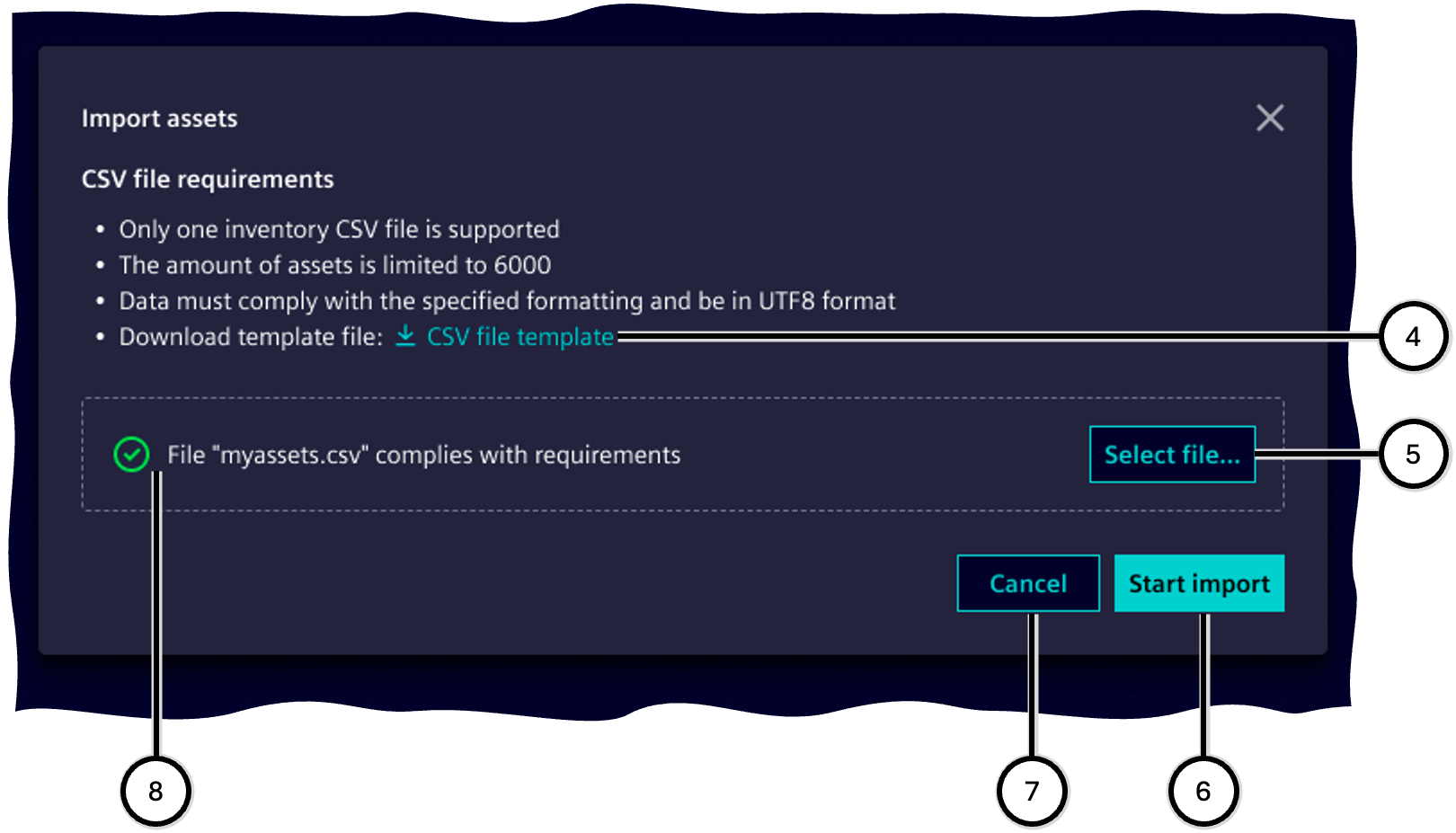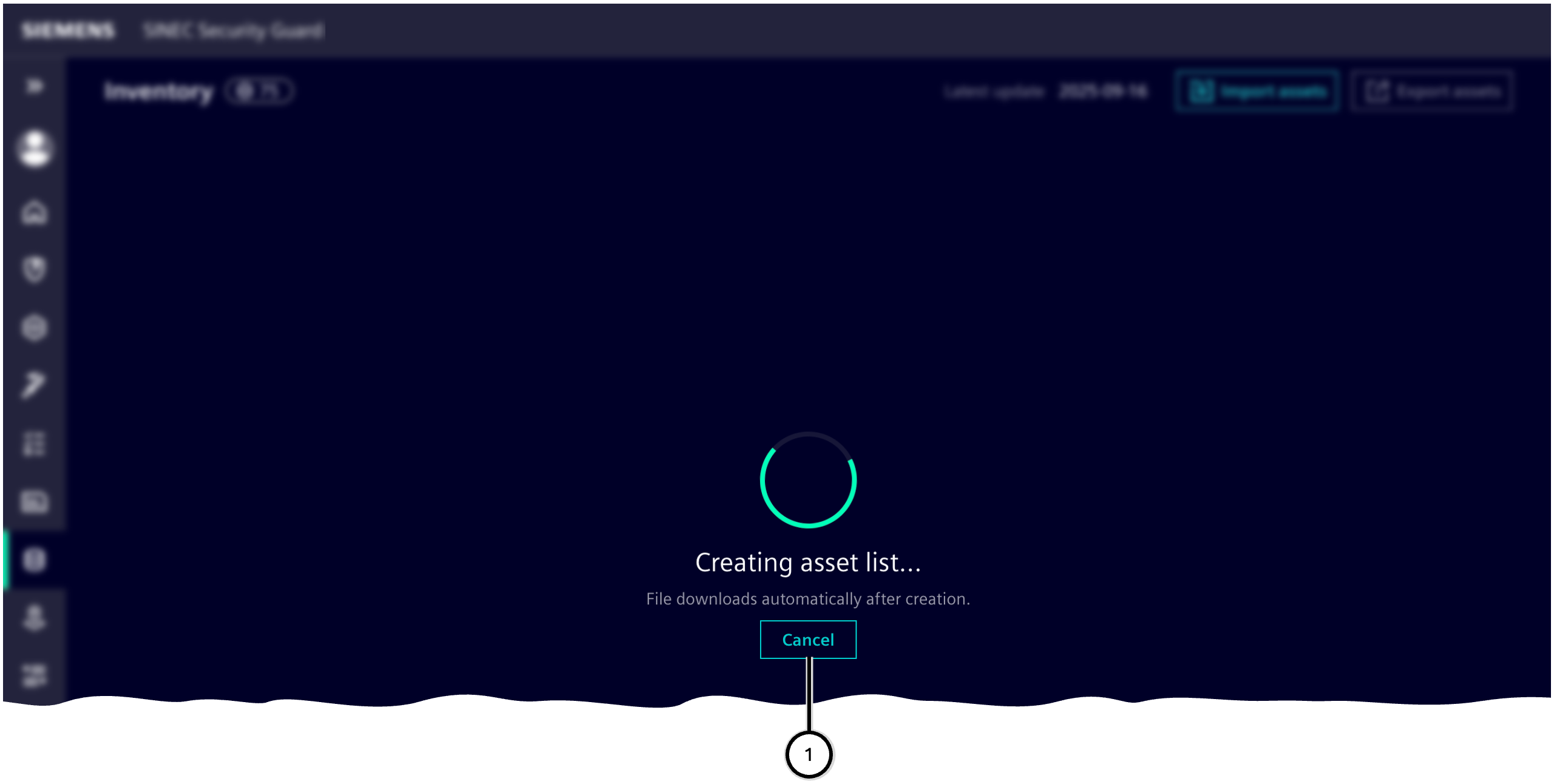Inventory
This area lists all assets that have been transferred from an update source (frequent synchronization with Siemens Industrial Asset Hub or import from a .CSV file) to SINEC Security Guard. Their total number ① is displayed separately.
Note The parallel use of both update sources (Siemens Industrial Asset Hub and .CSV file) is not possible.
The inventory lists assets which are transferred from the update source; the status of an asset is shown in the inventory - see column 'Status' ⑧.
| Status | Icon | Description | Remediation |
|---|---|---|---|
| Missing mandatory matching data |  |
Data which is required to identify the product is missing | Complete the data in the source |
| Missing vulnerability feed |  |
For this product there is no vulnerability feed known to retrieve vulnerability information from | Add the vulnerability feed of the asset's vendor |
| Matching data complete |  |
All data looks fine, but there is no vulnerabiliy detected for this product | None; as soon as a vulnerability becomes published for this product via the vulnerability feed, the data becomes validated automatically |
| Matching data validated |  |
Product and vulnerability feed data are fine | None |
Asset details ⑥ can be displayed for a selected asset.
The list of assets can be exported in a .CSV file for use in other systems ⑤.

| Number | Description |
|---|---|
| ① | Total number of supported and unsupported assets in the inventory |
| ② | Point of time of last inventory update |
| ③ | 'Table configuration' button |
| ④ | 'Import assets' button |
| ⑤ | 'Export assets' button |
| ⑥ | 'Show asset details' button |
| ⑦ | Cell with missing vulnerabiliy feed information |
| ⑧ | Cell with missing matching data |
| ⑨ | Input field for filtering the assets |
| ⑩ | List of assets |
Configuration of the table
It can be defined for the table, which columns are displayed in which order:
- Only these columns will be displayed which are selected in the configuration dialogue ②; single columns are selected and may not be deselected ①.
- The position of a column can be changed by dragging and dropping the column header to the desired position.
- With the reset button ③ one can go back to the standards configuration of the table.

| Number | Description |
|---|---|
| ① | Selected column (locked) |
| ② | Selected column |
| ③ | 'Reset to default' button |
| ④ | 'Cancel' button |
| ⑤ | 'Apply' button |
Necessity and impact of updates
During the update, the data from the update source replaces the previous inventory. The data is not added to the existing inventory.
During an update, the data for all assets in the future inventory must always be transferred together. Assets that are not present in the update source are removed from the inventory.
It is necessary to update the inventory if something changes in the hardware, firmware or configuration used, e.g. due to the replacement of assets, the installation of a firmware update or a changed IP address.
Per asset, a successful update has the following effect on new existing inventory:
| Asset exists in the previous inventory | Same asset exists in the update source (IAH or .CSV) | Effect on the new inventory |
|---|---|---|
| Yes | Yes | Asset data is replaced |
| Yes | No | Asset and all associated data and tasks are removed |
| No | Yes | Asset is newly added |
An update from a .CSV file fails if the file or its data structure is corrupt or if there is a problem with any given 'id' (either that any 'id' is missing or that any 'id' appears more than once). If an update from a .CSV file fails, nothing will be updated and the up-to-now existing inventory will remain untouched.
Synchronization with Siemens Industrial Asset Hub
Note The use of the update source Siemens Industrial Asset Hub is described here; importing from a .CSV file is then not possible. Contact Siemens Support if you have any questions.
The inventory automatically synchronizes with the Siemens Industrial Asset Hub in the background several times a day. Changes to assets or asset data in the Siemens Industrial Asset Hub are synchronized with SINEC Security Guard in a timely manner.
Import from a .CSV file
Note The use of the update source .CSV is described here; synchronization with Siemens Industrial Asset Hub is then not possible. Contact Siemens Support if you have any questions.
If an inventory is present in SINEC Security Guard, a note ② shows the age of the most recent import.
The import process is initiated via a button:
-
① shows the button in the event that there is no inventory;
-
③ shows the button in the event that an inventory is already present.
To import from a file, all asset data must be stored in a .CSV file in a defined structure. The necessary structure of the file is specified in the current template file, which you can download using a corresponding button ④. Always use the structure of the latest template version: Using a structure unlike the current template file leads to an error, and the already existing inventory in SINEC Security Guard remains untouched.
Files to be uploaded must meet the following criteria:
| Criterion | Description |
|---|---|
| File Format | .CSV (Comma Separated Values) UTF8 |
| Content Structure | as current template file |
| Maximum File Size | 150MB |
| Maximum Number of Records | 6000 |
| A unique 'id' per record | Each record must contain a unique value in the 'id' column; any record with either no value for 'id' or one that is used more than once in this file will lead to a failure and aborts the entire import process |
After the corresponding file has been selected ⑤ and the import has been initiated ⑥, these criteria are checked. If criteria are not met, the import is aborted and a corresponding error message is displayed in the status area ⑧; the already existing inventory remains untouched.
Note The structures of an exported .CSV file and of the template to import inventory data into SINEC Security Guard are identical, so an exported .CSV file may be used to later import the inventory into SINEC Security Guard again.

| Number | Function |
|---|---|
| ① | Button to import asset data from a .CSV file |

| Number | Function |
|---|---|
| ② | Age of the most recent import |
| ③ | Button to import asset data from a .CSV file |

| Number | Description |
|---|---|
| ④ | Button to download the current .CSV template |
| ⑤ | Button to select the .CSV file with asset data |
| ⑥ | Button to start the import process |
| ⑦ | Button to cancel the import process |
| ⑧ | Status display of the import process |
Data in .CSV file
Note The structure of the .CSV file may change over time. Siemens recommends to always download the latest version of the .CSV file. You may edit the file with any text editor or spreadsheet editor. Formatting and column separation work according to the CSV standard.
The .CSV file's first row shows the column headers. Each further row contains the data of one asset (= one record). The order of the columns is arbitrary.
The table below informs about the structure of the .CSV file; the table contains this information:
- Column: Each column in the .CSV file represents one parameter that adds data to each asset. If the file contains other columns, they and their data will be ignored.
- Description: Meaning of the parameter.
- Required for import process: 'Yes' means that the .CSV file must contain the column with this header, and also data per record. 'No' means that an import will also run if no data is given here.
- Asset processing: Parameters which are marked as 'Yes' are used to process the asset's data for the SINEC Security Guard purpose; when the record does not contain data here, processing of this asset in means of SINEC Security Guard is not possible.
| Column | Description | Required for import process | Asset processing |
|---|---|---|---|
| asset_id | Unique ID of the asset | Yes | No |
| asset_name | Name of the asset | No | No |
| product_vendor | Name of the company that has produced this asset | No | Yes |
| product_name | Name of the product - often used for non-Siemens assets | No | Yes. Only required if product_article_number is empty. |
| product_article_number | Article number of the asset, to be retrieved from the vendor | No | Yes. If empty, the product_name will be used. |
| zone_name | Name of the zone the asset belongs to | No | No. If empty: The asset gets applied to 'Unassigned assets'. If not empty: The asset gets applied to the zone of this name; if the zone doesn't yet exist, it becomes created. |
| ip | IP address of the asset (V4 or V6) | No | No |
| mac | MAC address of the asset | No | No |
| network_name | Name of the network the asset is part of | No | No |
| serial_number | Serial number of the asset | No | No |
| hardware_version | Hardware version of the asset | No | No |
| note | Leave any note here | No | No |
| firmware_version | Version of the firmware that is currently installed on the asset | No | Yes |
| new_asset_id | New unique identifier of the asset in case the identifier stated in asset_id shall be changed |
No | No |
Migrate the CSV imported data to the new format
- Export your current SINEC Security Guard -inventory into a .CSV file
- Keep the data in the column
asset_iduntouched (no changes, no removal) - In case you want to change
asset_idvalues: In the .CSV file, add a new column with the headernew_asset_id; this column will not show up in the template .CSV file or export .CSV file but has to be created manually when identifier shall be changed. - For rows you want to keep the identifier as given in the
asset_idcell: leave empty the respective cell in columnnew_asset_id - For rows you want to change the identifier: enter the desired new identifier into the column
new_asset_id, and take care that it is unique for both columnsasset_idandnew_asset_id - Save this file and import it into SINEC Security Guard
When importing a file with the column new_asset_id:
- All rows where the
new_asset_idcell is changed: The respective asset and all its remaining tasks will not be available anymore; an asset with the edited identifier becomes created and does not yet contain any tasks. - All rows where the
asset_idcell remains untouched and thenew_asset_idcell will keep their known identifier of the columnasset_id. - All rows where the
asset_idcell remains untouched and thenew_asset_idcell contains a value will use the new identifier instead of their known identifier and will update all relations inside SINEC Security Guard accordingly.
This process ensures that all data relations between the assets and their tasks are kept for both the assets which keep their identifier and the assets which get a newly defined identifier.
Export
The records of the inventory can be exported to a .CSV file. This file may be used to work with the data in other applications and systems. When starting the export, the .CSV file becomes created and downloaded to your system - consult the settings of the browser and the operating system you use to see where to find the file.
Depending on the internet connection and the number of records, the export process may take some time. As long as the process continues, SINEC Security Guard cannot be used otherwise. The export process can be cancelled ①. The name of the .CSV file contains date and time of the export.
Note Currently the structures of an exported .CSV file and the template to import data into SINEC Security Guard differ. To import data from an exported .CSV file one needs to apply the data to the structure of the import template file.

| Number | Description |
|---|---|
| ① | Button to cancel the export process |